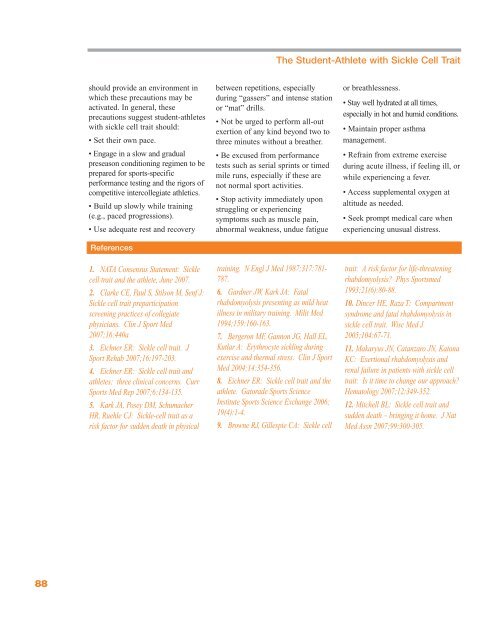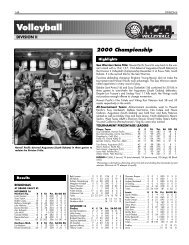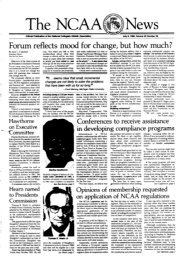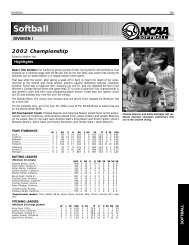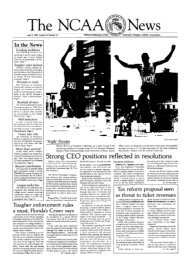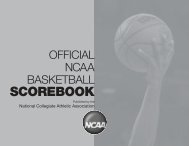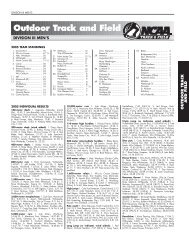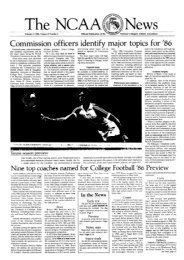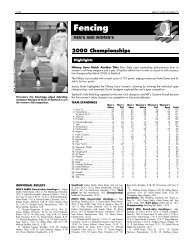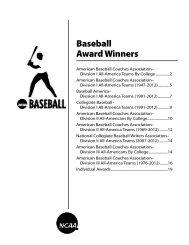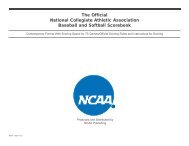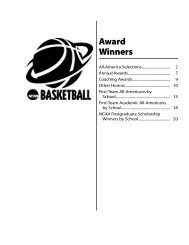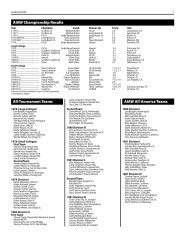Sports Medicine Handbook - NCAA
Sports Medicine Handbook - NCAA
Sports Medicine Handbook - NCAA
You also want an ePaper? Increase the reach of your titles
YUMPU automatically turns print PDFs into web optimized ePapers that Google loves.
88<br />
should provide an environment in<br />
which these precautions may be<br />
activated. In general, these<br />
precautions suggest student-athletes<br />
with sickle cell trait should:<br />
• Set their own pace.<br />
• Engage in a slow and gradual<br />
preseason conditioning regimen to be<br />
prepared for sports-specific<br />
performance testing and the rigors of<br />
competitive intercollegiate athletics.<br />
• Build up slowly while training<br />
(e.g., paced progressions).<br />
• Use adequate rest and recovery<br />
References<br />
1. NATA Consensus Statement: Sickle<br />
cell trait and the athlete, June 2007.<br />
2. Clarke CE, Paul S, Stilson M, Senf J:<br />
Sickle cell trait preparticipation<br />
screening practices of collegiate<br />
physicians. Clin J Sport Med<br />
2007;16:440a<br />
3. Eichner ER: Sickle cell trait. J<br />
Sport Rehab 2007;16:197-203.<br />
4. Eichner ER: Sickle cell trait and<br />
athletes: three clinical concerns. Curr<br />
<strong>Sports</strong> Med Rep 2007;6:134-135.<br />
5. Kark JA, Posey DM, Schumacher<br />
HR, Ruehle CJ: Sickle-cell trait as a<br />
risk factor for sudden death in physical<br />
between repetitions, especially<br />
during “gassers” and intense station<br />
or “mat” drills.<br />
• Not be urged to perform all-out<br />
exertion of any kind beyond two to<br />
three minutes without a breather.<br />
• Be excused from performance<br />
tests such as serial sprints or timed<br />
mile runs, especially if these are<br />
not normal sport activities.<br />
• Stop activity immediately upon<br />
struggling or experiencing<br />
symptoms such as muscle pain,<br />
abnormal weakness, undue fatigue<br />
training. N Engl J Med 1987;317:781-<br />
787.<br />
6. Gardner JW, Kark JA: Fatal<br />
rhabdomyolysis presenting as mild heat<br />
illness in military training. Milit Med<br />
1994;159:160-163.<br />
7. Bergeron MF, Gannon JG, Hall EL,<br />
Kutlar A: Erythrocyte sickling during<br />
exercise and thermal stress. Clin J Sport<br />
Med 2004;14:354-356.<br />
8. Eichner ER: Sickle cell trait and the<br />
athlete. Gatorade <strong>Sports</strong> Science<br />
Institute <strong>Sports</strong> Science Exchange 2006;<br />
19(4):1-4.<br />
9. Browne RJ, Gillespie CA: Sickle cell<br />
The Student-Athlete with Sickle Cell Trait<br />
or breathlessness.<br />
• Stay well hydrated at all times,<br />
especially in hot and humid conditions.<br />
• Maintain proper asthma<br />
management.<br />
• Refrain from extreme exercise<br />
during acute illness, if feeling ill, or<br />
while experiencing a fever.<br />
• Access supplemental oxygen at<br />
altitude as needed.<br />
• Seek prompt medical care when<br />
experiencing unusual distress.<br />
trait: A risk factor for life-threatening<br />
rhabdomyolysis? Phys <strong>Sports</strong>med<br />
1993;21(6):80-88.<br />
10. Dincer HE, Raza T: Compartment<br />
syndrome and fatal rhabdomyolysis in<br />
sickle cell trait. Wisc Med J<br />
2005;104:67-71.<br />
11. Makaryus JN, Catanzaro JN, Katona<br />
KC: Exertional rhabdomyolysis and<br />
renal failure in patients with sickle cell<br />
trait: Is it time to change our approach?<br />
Hematology 2007;12:349-352.<br />
12. Mitchell BL: Sickle cell trait and<br />
sudden death – bringing it home. J Nat<br />
Med Assn 2007;99:300-305.


